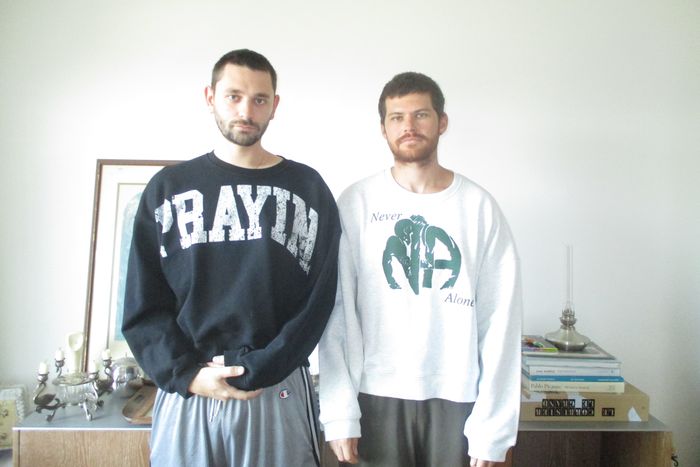When Adidas, the world’s second-largest footwear company, called on niche streetwear brand Praying to revive an old sneaker, no one was more surprised than its founders. “They basically said, ‘Do whatever you want,’” recalls Alex Haddad, one half of the duo behing Praying. “So then we just threw ‘Praying’ on it, which worked, because that’s kind of the brand. We just write things on clothes.”
Last month, the collaboration was announced with a photo of TikTok ingenue Addison Rae in Praying’s signature “Father, Son, and Holy Spirit” bikini. The image went viral, mostly due to outrage from random social-media accounts run by Christian fundamentalists and conservatives. Within days, Rae and Praying had scrubbed the image from their feeds and Haddad says that Adidas deemed the ordeal “the worst social-media disaster of 2022.” (The shoe brand declined to comment on specifics.)
However, Praying — which seems to delight in inciting internet trolls with minor controversy — only gained followers and notoriety in the wake of this episode. The label seems to exemplify a larger cultural shift away from woke earnestness and toward cynicism and irony; it was God-pilled before anyone started asking if Catholicism is cool again. Given all of this, it would be easy to see Praying as evidence of Gen Z’s embrace of nihilism or a sign of some larger religious resurgence. But is Praying and its Jesus-themed bikinis really that deep?
After launching in January 2020, Praying quickly built a catalog of flammable basics stamped with Christian slogans (short shorts with lines from First Corinthians) and Y2K imagery (a Brangelina purse). It was quickly picked up by Gucci’s online concept store, partnered with Ssense on a collection, and is favored by the likes of Megan Thee Stallion and Olivia Rodrigo, who have worn its best seller, a crop top bedazzled with the words “God’s Favorite.” (Praying’s prices start around $50 for a tank top and rarely exceed $200.)
The company’s founders say most of their customers are “probably girls, younger girls” — like the kind who model their clothes and appear (somewhat misleadingly) in the press images that accompany most of the founders’ interviews. People are sometimes surprised to find that Praying is made by two 30-year-old “white guys with laptops,” Haddad says sheepishly. “We get hella DMs that are like, ‘Bestie, when are you going to drop this, girly?’” adds Skylar Newman, Praying’s co-founder.
I meet Newman and Haddad at the citizenM hotel on the Bowery, where they hand me a small white shoulder bag printed with the word praying in glittery, bedazzled sticker motifs. It’s a perfect distillation of the brand: recognizable and funny to the very online but glitchy and ugly to everyone else. Haddad designed it on Instagram Stories — just like the Holy Trinity bikini. “I searched ‘bikini,’ then just wrote ‘Father,’ ‘Son,’ ‘Holy Spirit,’” he explains. “I sent it to Skylar, and he was like, ‘We’re going to hell.’”
Newman grins at the memory. He’s the smaller and shyer of the two, with a reddish beard that clashes with the knock-off pink Vetements shirt he just bought on Canal Street. He’s sipping a giant Heineken and shrugs off questions about his wealth of practical business and marketing experience, a background that includes top roles at e-commerce and marketing start-ups, advertisement for brands like Asics, and marketing for dating sites like Adult FriendFinder.
“If you searched ‘I want to fuck somebody’ on Google, my ads would come up,” he says, adding that his experience directly informed Praying’s web-design and marketing strategy. “I’ve made a bunch of dumb-ass shit.” A 2019 gig making merch for Netflix gave him the production experience and connections to help launch Praying with Haddad, his best friend of the past decade. At the time, Haddad was using his master’s degree in architecture from Columbia to design hospitals for Mount Sinai that would never be built.
“We hated having office jobs,” Haddad says, sharing a contemplative Juul rip with Newman.
Haddad is newly married and newly sober and looks the artist in a black Balenciaga jacket, jean cutoffs, and scuffed loafers. As the creative mind behind most of Praying’s designs, can he explain why it’s so popular? “It’s hard to say sometimes, because we are not our audience,” he says. “We don’t really know, because we’re so removed. We have our own lives. This is a project for us.”
Praying’s DNA can be traced back to its founders’ early-aughts upbringings. The two credit the brand’s aesthetic to older sisters who loved platform flip-flops and low-rise jeans; as for the Christian symbolism, both men grew up religious. Haddad was raised in a Polish Catholic family and attended Jesuit school in San Francisco (“It was, like, liberal God”), while Newman grew up between Jewish and Southern Baptist households — also in California. His grandmother’s house, he remembers, was littered with the kind of iconography that Praying now sells on tank tops.
They both “fucking hated” their religious inculcation, thought it was “mad boring,” and “couldn’t tell you anything” they’d learned. But while Newman no longer believes in God, Haddad, after falling off in college, says he’s now a practicing Catholic, though he doesn’t go to church.
“I pray … it’s kind of just a personal thing,” he says, vaguely. “I don’t know. It’s weird. I think I believe in God.” He rhapsodizes for a while on the absurdity of Catholicism — “The Eucharist, you’re eating a fucking cracker from Walmart, but you’re literally supposed to be eating the body of God.” — and speculates on the existence of a higher power (he seems undecided). Eventually, Newman breaks in: “Praying is how he worships.”
“Yeah,” Haddad laughs. “This is my form of praying,” he says, gesturing to the sticker bag.
Some of Praying’s consumers really do seem to engage with the brand at face value. One is a childhood friend of mine who used to carry a Bible in her backpack before she ditched it for astrology in college. That was up until last year, when she started to wear rosaries with a straight face. Her return to religion, she says, was accompanied by her discovery of Praying. She says the brand allowed her to “get back into praising God but on my own terms.”
This kind of earnest engagement is what Haddad is going for; in fact, the interpretation of Praying as crude and insincere seems to distress him. “People say so much shit about Praying, but one of the main comments is, like, ‘Just because you don’t believe in God doesn’t mean you should mock my religion,’” he says. “And I’m like, ‘One: I never said I don’t believe in God. Two: I’m not mocking anything.”’
Still, others come to Praying for the internet irony: “It’s kind of silly and ugly, and there’s a sense that it’s a little bit iconoclastic but in a relaxed way,” says writer Marlowe Granados, who owns the brand’s “Give Girls Money” tee. “Definitely, it’s empowering,” Haddad’s wife, Autumn — a kind of consultant, model, and muse for the label — tells me. “In a world where you’re constantly having to battle criticism, it’s awesome to have the power to wear something that’s proclaiming something and that makes you feel good about yourself, where you’re like, Wow, I feel really hot in this.” (She was the inspiration for Praying’s “Trophy Wife” shirt, her husband says.)
A lot of people are bewildered by Praying — like my sister-in-law, a college senior who laughed in my face when I tried to give her the sticker purse. (Eventually, it was claimed by my 8-year-old niece, who liked the glitter decals.)
Not that Praying is aiming for universal appeal. If some of its clothes are ugly, that’s on purpose: They’re designed with an alienating aesthetic theory in mind that Haddad and Newman call “trashworld.”
Visually, trashworld what you see when you search “cursed images” on Google. Intellectually, it’s what Haddad describes as a surrender to certain shitty realities of modern life — namely, climate change and capitalism — because you feel powerless to change them.
“If you accept the atrocities of the situation, that the world is a nihilistic place, then it’s easier to move past rather than just deny, deny, deny, deny,” explains Haddad.
Basically, if things are bad, you just join the party and make them worse. “Yeah,” adds Newman, reading my mind. “If you know you’re in a trashworld, then you can just move trash.”
Perhaps Praying really is channeling some complex Gen-Z angst about the end of the world. But maybe it’s not that complicated — after all, using ironic religious symbolism to get a rise out of your elders is the oldest trick in the book (see: punks, Madonna, Lil Nas X). What’s more childishly provocative than writing “holy spirit” on some underwear?
In any case, the duo has big plans: A meeting with one of the world’s most prominent designers is on the books, and they went to men’s fashion week in Paris, where they were “gassed up by real fashion people.” Haddad’s eyes brighten as he fantasizes about a runway show and a Praying wedding gown, “a sequin dress made of AA tokens.”
“We want to be the biggest brand in the world,” he says without a hint of irony.



